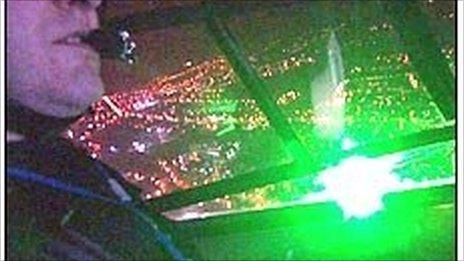How dangerous are lasers to planes?
- Published
A New York-bound Virgin Atlantic flight was forced to return to Heathrow Airport after being struck by a laser beam - most likely from a hand-held laser pointer. But how dangerous are these devices? And what does the law in the UK say about their use?

What type of lasers are used?
According to the UK government, laser pointers - also known as laser pens - are those most commonly used against planes. They are usually portable, low-powered battery-operated devices.

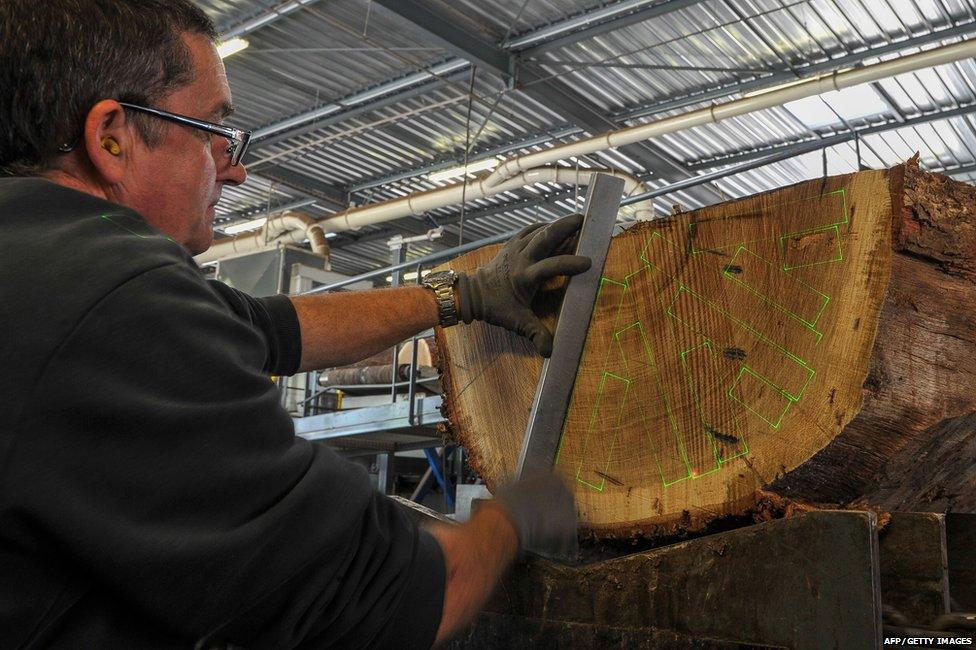
High strength lasers can be used to cut tree trunks
How powerful are they?
Lasers are categorised by strength, ranging from Class 1 lasers - including those used to play CDs - to Class 4 devices - which can be strong enough to cut metal and to medically treat eyes. There are seven different levels of laser, in four classes.
However, the strength of laser pens can vary widely.
Laser pens should have a maximum one milliwatt (mW) power output when sold to the public - one thousandth of a watt - according to Public Health England (PHE) guidelines, external.
Such pointers are too weak to damage eyes - apart from in exceptional circumstances.
However, PHE says it has found laser pointers available to buy that are much stronger, with many found to be Class 3 or higher.
It says: "A number of high-power laser pointers, generally emitting green beams, are available over the internet. The laser beam powers may be up to a few hundred milliwatts.
"These devices are extremely dangerous and are not suitable for sale to the public."

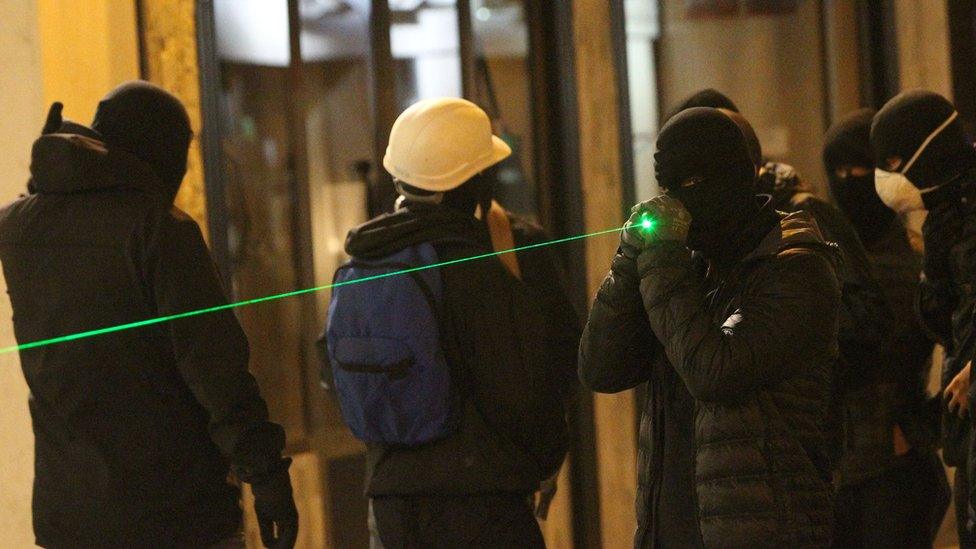
A protester in France was photographed using a laser
What do medics say?
Fahd Quhill, a consultant ophthalmologist at the Royal Hallamshire Hospital in Sheffield, says any laser beam has the potential to distract and disturb a pilot.
However, lasers would have to be extremely powerful to blind someone at 1,300ft (396m).
Mr Quhill treated a pilot whose eye was injured by a laser, which he suspects was several thousand times more powerful than guidelines recommend. It left him "flash blind" and unable to see for 45 minutes. The pilot has also suffered permanent damage to the eye, although he retained his sight.
"It was enough to cause injury to the retina. If the angle had been different it could have left him blind," he added.
He has also treated 10 children who have suffered permanent damage after beams were shone in their eyes, again from pens significantly above the 1mW guideline.
Most were found to be 40-100 time more powerful than recommended, Mr Quhill added.

How easy are they to get hold of?
Laser pens are not illegal in the UK and are widely available online, costing anything from £20 to £500. Those sold in the UK are usually classified in accordance with the current safety standards.
However, stronger lasers can be imported via the internet. One South Korean-based website offers to ship the "world's most powerful handheld laser" to the UK, starting from $199 (£137).
According to David Taylor, of National Police Air Service (NPAS), it is "extremely easy" to pick up lasers on the internet that are about 5,000 times more powerful than the strength of a typical classroom pointer.

What damage can they cause planes?
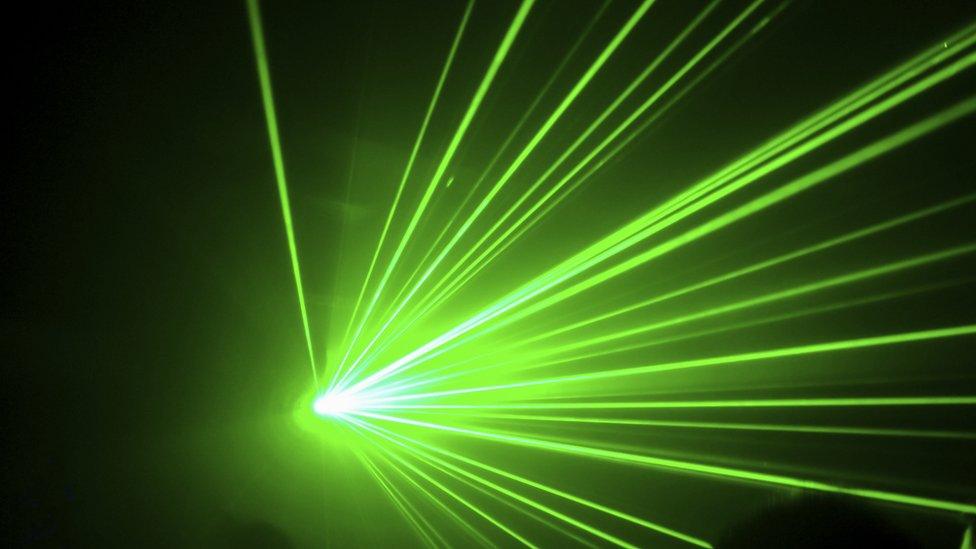
Aviation industry experts say lasers can be "very" dangerous to pilots, and therefore planes.
Commercial airline pilot Janet Alexander says: "It's very like a lightning strike in that it's very instantaneous, very bright light, which is dazzling. If it's targeted in exactly the wrong way you could permanently damage someone's sight."
Aviation security expert Julian Bray says such shining lasers into cockpits presents a threat to the entire plane.
Pilots can be "temporarily blinded" and can receive retina damage, or receive "a very nasty headache", adding: "So it is very dangerous indeed."

How common is it?

Between January 2009 and June 2015 more than 8,998 laser incidents across the country were reported to the UK Civil Aviation Authority., external
In 2014 alone, there were 1,440 reported incidents in the UK. Heathrow had the most, at 168.
Manchester International airport had the second most in that period, with 107, followed by Birmingham airport, with 92, and Leeds Bradford airport, with 81.

Is it illegal?
Jim McAuslan, British Airline Pilots Association: "Make lasers an offensive weapon"
In 2010, a law was passed in the UK which allows offenders to be charged with "shining a light at an aircraft in flight so as to dazzle or distract the pilot".
If the distraction or dazzle is serious, a person may be found guilty of "reckless endangerment" and sent to prison.
Between 2010 and 2014, 199 people were convicted of the offence in the UK.
Last year, a man who targeted a Police Scotland helicopter with a laser pen was jailed for 12 months after detectives used thermal imaging equipment to locate him.
In 2014 three men from Leicestershire were jailed for using laser pens to dazzle pilots coming in to land at East Midlands Airport.
It is still not an offence to possess a laser, but the NPAS wants stronger laws in the UK to crackdown on the purchase and use of lasers.
Lasers should be classed as "offensive weapons" and banned in the UK, the British Airline Pilots Association said.

- Published15 February 2016
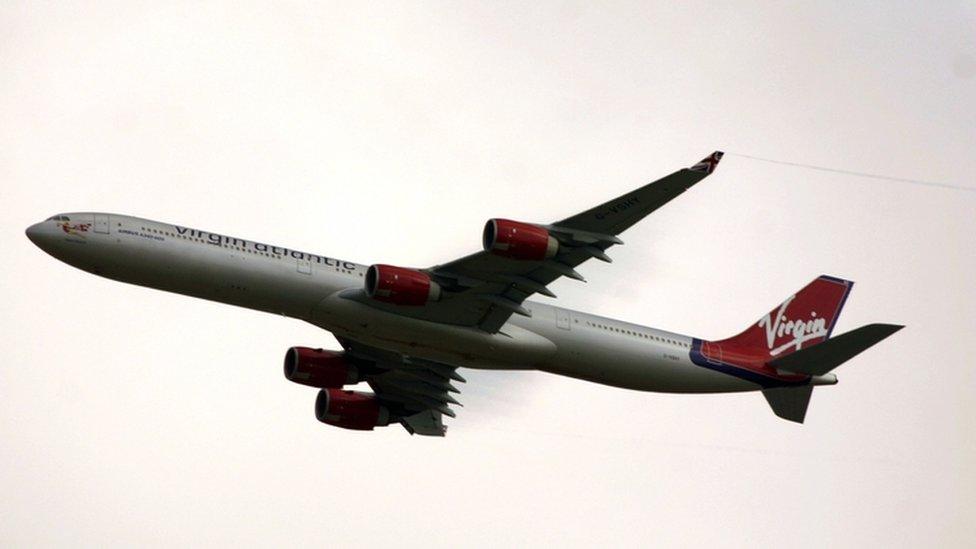
- Published20 October 2015
